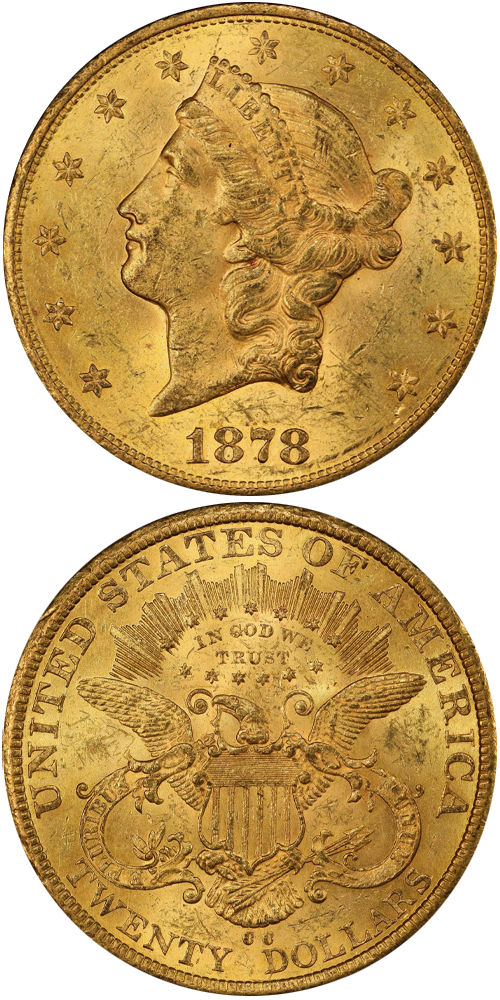1878-CC Liberty Head Double Eagle
Jeff Ambio: The two known varieties of the 1878-CC double eagle are easily distinguished from one another. The obverse of the Winter 2-B variety is identifiable by the presence of a small raised die dot at the denticles before star 11. The date is nearly centered in the field between the base of Liberty's portrait and the denticles, although it is slightly closer to the latter. On the reverse of this variety, there are faint, yet discernible die lines bisecting the letters M and E in AMERICA, as well as a patch of roughness in the field after that word and several spikes protruding from the letter S in DOLLARS. The first C in the mintmark is centered over the space between the words TWENTY and DOLLARS and the second C is over the left edge of the upright of the letter D in the latter word. The second C is a bit higher than the first. This is by far the rarer of the two known die marriages of the issue, and Doug Winter was aware of just two examples when writing the book Gold Coins of the Carson City Mint (2001).
Rusty Goe: In a year in which coinage would cease for subsidiary silver pieces and trade dollars, and production would begin on a new version of the standard silver dollar, the Carson Mint would see its gold-coin turnout dwindle even further. Apparently a supply of about 11,500 double eagles, which Chief Cashier William Byrne held in his vault in April, was sufficient to meet the needs of the contracted quantities of gold bullion deposits coming in at that time.
By 1878, the Carson City branch was struggling to survive -- doing so only because of the Bland-Allison Act, which called for huge quantities of silver dollars.
In February, Coiner Levi Dague delivered the first double eagles of the year at the Carson Mint -- 8,000 of them. He delivered only 1,408 more double eagles before the end of June, and added only 3,772 in the second half of the year; the work schedule was reduced by two months because of a renovation project in October and November.
With its paltry original mintage figure -- the second lowest in the Carson Mint's first nine years -- one would think the 1878-CC double eagle would be much rarer than the extant population we see today. Thanks to an unusually high survival rate of four to five percent -- at least as reported by the grading services -- collectors have an adequate supply from which to choose. Surprisingly, however, auction appearances of examples of this date are suspiciously infrequent. This becomes even more apparent for Mint State specimens. The population in this category is limited -- perhaps only ten or so examples.
Q. David Bowers: The mintage of only 13,180 1878-CC double eagles suggests a rarity, and a rarity this is. I estimate that about 250 to 350 exist overall with five to eight deserving of the Mint State label. Again, due to gradeflation, resubmissions, and the repeated appearance of certain of the same coins at auction, facts are scarce.
VF and EF grades are about par for this issue, and at the AU level, especially if with attractive surfaces, the 1878-CC is very elusive. In the Mint State category all are in lower ranges, save perhaps for one mentioned by David W. Akers in 1982, a piece found in Europe in the 1960s, brought to America, and sold into the Milt Kaufman Collection.
The example to the left was sold by Stack's Bowers Galleries in the Fairmont Collection, Hendricks Set, where it realized $120,000.






